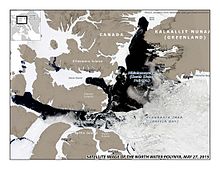North water
Location of the north water |


The North Water ( Greenlandic Pikialarsorsuaq , English North Water Polynya ) is the largest polynja in the Canadian Arctic . It forms annually in the northern part of Baffin Bay and southern Smithsund between 76 ° and 79 ° North and between 70 ° and 80 ° West. It is bounded in the west by the fast ice of the Devon , Coburg and Ellesmere Islands , in the southeast by the Carey Islands and in the northeast by Greenland . In summer it reaches a maximum size of around 80,000 km². The biologically productive north water is a local island of biodiversity .
Emergence
The north water forms as soon as an ice bridge is formed in the Kaneb basin in winter , which blocks the flow of sea ice from the Lincoln Sea into the northern Baffin Bay. The prevailing, often stormy northerly winds cause young sea ice in Smithsund and adjacent areas of Baffin Bay to break up regularly and drift south and prevent the formation of a stable ice sheet. In addition, thermal effects from rising warmer water along the Greenland coast, which play a role in the spread of polynya in late spring, are being discussed among scientists. The northern water remains small until April, but produces considerable amounts of sea ice that is transported south. In the spring, the polynya expands quickly until the ice cover in the central part of Baffin Bay also dissolves in August.
fauna
The north water is an area of increased biological activity. The open water and thin ice allow early flowering of phytoplankton in spring , which can last up to six months and thus three months longer than in adjacent ice-covered parts of the sea, such as Lancastersund . Phytoplankton is at the beginning of the food chain , in which the Greenland cod ( Arctogadus glacialis ) plays a key role. It is the food source of large populations of marine birds and mammals . It is estimated that the crab grebe , a small representative of the alkenbirds , nests here with 14 to 30 million pairs. Other seabirds are the thick-billed mum , the fulmar , the black guillemot , the kittiwake , the ice gull and the rare ivory gull . In total there are around 25 species of sea birds in the area.
Around 10,000 beluga whales overwinter in the north water each year before they move to their summer quarters in the fjords of Lancaster Sound in June . Narwhals and bowhead whales can be found in smaller numbers all year round. Also walruses , ringed seals , bearded seals and polar bears inhabit the polynya in all seasons.
history
The northern water with its high density of marine mammals and birds has offered the various, alternating Inuit cultures rich hunting grounds for around 5000 years. There is evidence that the Grænlendingar traded with the polar skimos and became acquainted with the polynya in the 13th century . The first guaranteed voyage by Europeans to the north water is that of William Baffin and Robert Bylot on the Discovery in 1616. On July 1, they reached open water south of Cape Dudley Digges at 75 ° 40 ′ north and discovered the entrance to it four days later the Smithsund. Only 200 years later did ships return to northern Baffin Bay. In search of the Northwest Passage , John Ross sailed the north water with the HMS Isabella and the HMS Alexander . The north water got its name from the whalers of the 19th century, who could hunt here in the spring if they managed to cross the dangerous Melville Bay .
literature
- Kirsten Hastrup, Anders Mosbech, Bjarne Grønnow (Eds.): The North Water: Interdisciplinary studies of a High Arctic polynya under transformation . In: Ambio . Volume 47, No. 2 Supplement, 2018, pp. 159-309 (English).
Web links
- North Water Polynya on Oceans North Canada website
Individual evidence
- ↑ North Water polynya on oceansnorth.org, accessed on May 6, 2014.
- ↑ a b Walker O. Smith, Jr., David Barber: Polynyas. Windows to the World . Elsevier, 2007, ISBN 978-0-444-52952-7 , pp. 34–36 ( limited preview in Google Book search).
- ^ Moira Dunbar The Geographical Position of the North Water (PDF; 720 kB). In: Arctic . Volume 22, No. 4, 1969, pp. 438-441. doi : 10.14430 / arctic3235
- ^ Elisabeth Levac, Anne De Vernal, Weston Blake, Jr .: Sea-surface conditions in northernmost Baffin Bay during the Holocene. Palynological evidence ( Memento from May 11, 2011 in the Internet Archive ) (PDF; 900 kB). In: Journal of Quaternary Science . Volume 16, No. 4, 2001, pp. 353-363. doi : 10.1002 / jqs.614
- ↑ Julie Bâcle: The physical oceanography of waters under the North Water Polynya (PDF; 6.6MB), master thesis, McGill University, Montreal 2000
- ↑ a b c North Water ( Memento of June 22, 2009 in the Internet Archive ) on the website of the Université Laval
- ↑ Keith A. Hobson, Aaron Fisk, Nina Karnovsky, Meike Holst, Jean-Marc Gagnon, Martin Fortier: A stable isotope (δ 13 C, δ 15 N) model for the North Water food web: implications for evaluating trophodynamics and the flow of energy and contaminants (PDF; 1.1 MB). In: Deep-Sea Research II . Volume 49, 2002, pp. 5131-5150
- ^ Ian Stirling: The Biological Importance of Polynyas in the Canadian Arctic (PFD; 947 kB). In: Arctic . Volume 33, No. 2, 1980, pp. 303-315.
- ↑ Narwhal, Belugas & Bowhead on oceansnorth.org, accessed May 6, 2014.
- ↑ Thomas Rundall: Narratives of voyages towards the north-west, in search of a passage to cathay and india, 1496 to 1631 , pp. 138 ff.
Coordinates: 77 ° 0 ′ N , 74 ° 0 ′ W
